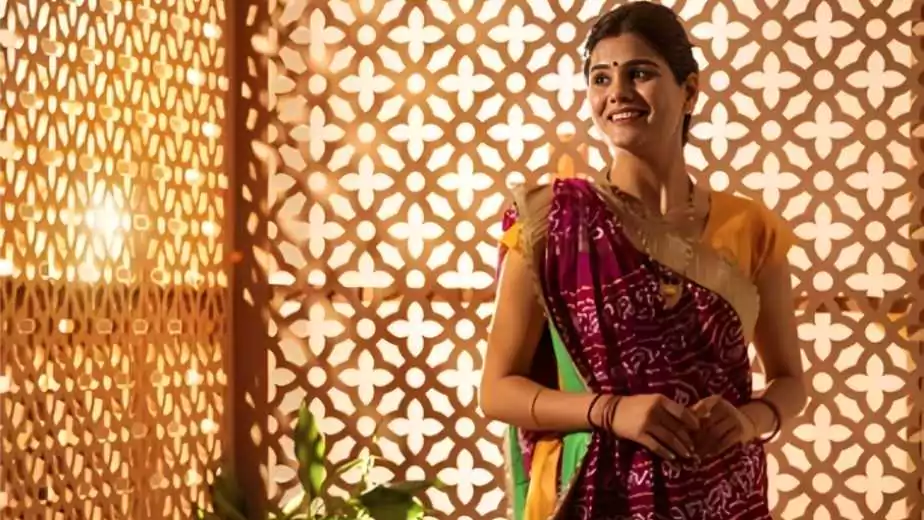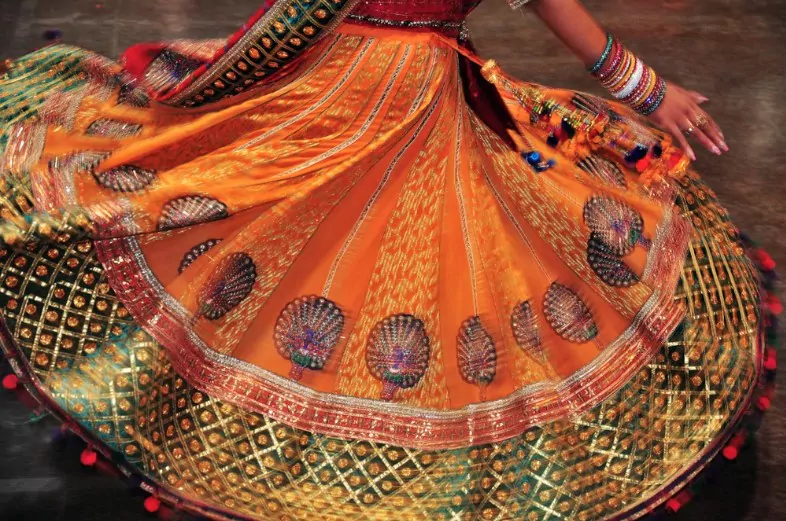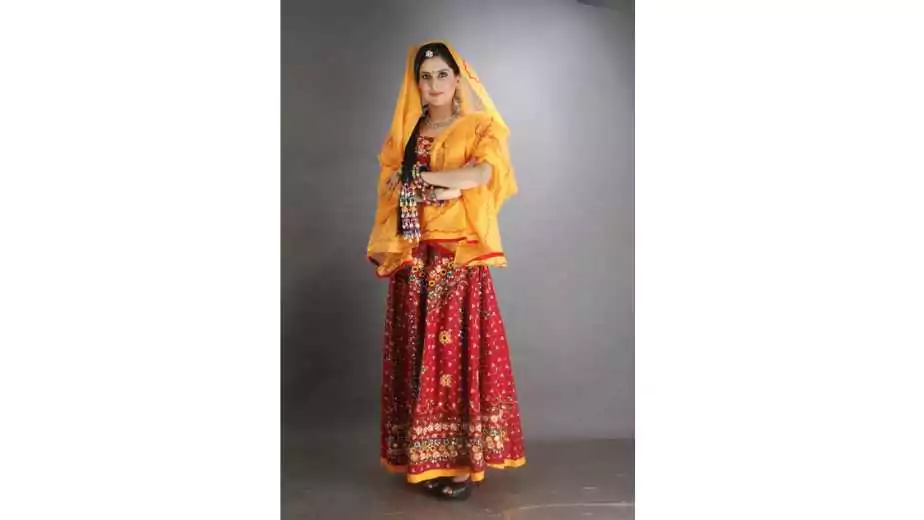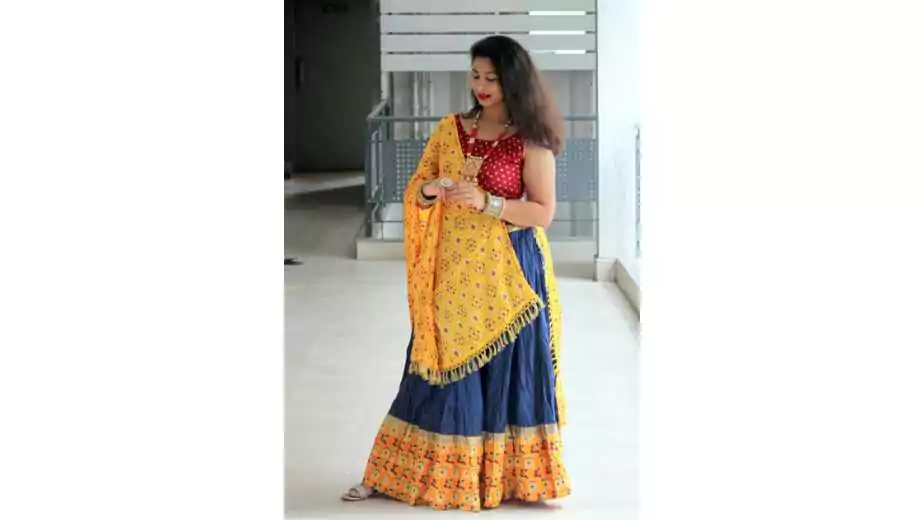How To Wear Gujarati Saree: A Step-by-Step Guide

The Indian saree, emblematic of grace, showcases a rich diversity in its styles and draping methods, with the Gujarati saree standing out for its vibrant designs and unique draping style. Renowned for its bright colors, exquisite patterns, and intricate embroidery, the Gujarati saree—or ‘Pallav style’—is a celebration of Gujarat’s rich cultural heritage. Its defining feature is the front-displayed pallu, which contrasts with traditional draping methods, allowing its elaborate work to be prominently showcased.
This blog delves into the Gujarati saree’s elegance, offering a step-by-step guide to not only understand its distinctiveness but also to master wearing it in a way that flatters the figure. Whether you’re new to this garment or looking to perfect your draping technique, this guide is designed to help you how to wear Gujarati saree with poise and sophistication.
1 The Basics of Gujarati Saree
The Gujarati saree, with its deep roots in the rich tapestry of Indian tradition and culture, carries a history that is as colorful and intricate as the saree itself. This garment is not just a piece of fabric; it is a canvas that narrates stories of heritage, craftsmanship, and the socio-economic conditions of its time. The tradition of wearing sarees in Gujarat, as in much of India, dates back centuries, evolving through the ages to adapt to the changing tastes and influences of different eras.
Brief History and Significance
Historically, the Gujarati saree has been a symbol of grace and pride for the women of Gujarat. It has played a significant role in every Gujarati woman’s life, being intricately woven into the fabric of daily wear, festive occasions, and ceremonial rites. The craftsmanship and beauty of these sarees were once the preserve of royalty and the affluent, showcasing motifs and patterns inspired by local folklore, nature, and the artisans’ creativity. Over time, the Gujarati saree has transcended these boundaries, becoming accessible to a broader audience, yet it continues to hold a place of reverence and cultural significance.
Key Characteristics
What distinguishes the Gujarati saree from other styles are several key characteristics:
The Front-Facing Pallu: The most defining feature of the Gujarati saree is the draping of the pallu or the decorative end of the saree. It is draped over the right shoulder and brought to the front over the left shoulder, displaying the saree’s intricate designs prominently on the wearer’s front, unlike the more common back-facing pallu in other styles.
Elaborate Work and Embellishments: Gujarati sarees often feature heavy zari work, mirror work, and exquisite embroidery that reflect the state’s rich artisanal heritage. The use of vibrant colors combined with intricate designs adds to the saree’s allure, making it a popular choice for festive occasions.
Bandhani and Patola Prints: Among the variety of Gujarati sarees, Bandhani (tie-dye) and Patola (double ikat) prints are the most famous. These traditional techniques involve labor-intensive processes that result in unique patterns and a rich texture, embodying the essence of Gujarati craftsmanship.
Fabric Choices: The Gujarati saree is not confined to any single type of fabric. It embraces a variety, from luxurious silks to lightweight cottons, each selected to suit the climate, occasion, and personal preference of the wearer.

2 Preparations Before Draping
Before delving into the intricacies of draping a Gujarati saree, it’s crucial to lay the groundwork with the right selection of saree, blouse, petticoat, and accessories. These preparatory steps are essential in achieving a look that is not only traditional but also flattering and stylish.
Selecting the Right Saree

Choosing the right saree is pivotal in accentuating your figure and enhancing the appearance of slimness. Here are a few tips to keep in mind:
Fabric Choice: Opt for lightweight and fluid fabrics such as georgette, chiffon, or fine silk. These materials drape closely around the body, highlighting your contours gracefully without adding bulk.
Color and Print: Darker colors tend to have a slimming effect. When selecting prints, go for smaller motifs or vertical lines that elongate the body visually. Avoid large, bold prints that can overpower your frame.
Border and Work: Sarees with thin borders or no borders at all can make you appear taller and slimmer. If you prefer sarees with embellishments, look for ones with delicate work along the borders and pallu, rather than all over the saree, to maintain a sleek silhouette.
Choosing Blouse and Petticoat
The right blouse and petticoat are just as important as the saree itself:
Well-fitted Blouse: A well-fitted blouse enhances your figure and provides the necessary support. Choose a design that complements the saree and your body type. For a slimming effect, consider blouses with longer sleeves and a length that ends just below the ribcage.
Petticoat: The petticoat should be of a matching color and snugly fit your waist, with a straight cut rather than flared. This ensures a smooth silhouette under the saree. Opt for a petticoat with a drawstring or an elastic waistband for a comfortable, adjustable fit.
Accessories to Complement Your Look
Accessories play a vital role in completing your Gujarati saree ensemble:
- Traditional Accessories: Add elegance with traditional Gujarati jewelry such as Jhumkas (earrings), bangles, and necklaces. A maang tikka or a passa can also enhance the ethnic look.
- Modern Accessories: For a contemporary twist, consider minimalist jewelry pieces or a statement watch. A stylish clutch or a potli bag can also add to your modern Gujarati saree look.
- Footwear: Choose heels or wedges to add height and ensure the saree’s hem falls gracefully. Select a pair that complements the color and style of your saree.
Step-by-Step Guide on How to Wear Gujarati Saree
Draping a Gujarati saree with elegance involves a series of steps that, when followed carefully, result in a beautiful and graceful look. Here’s a detailed guide to help you master the art of wearing a Gujarati saree.
Step 1: Tucking and Pleating the Saree
- Start with the Saree: Begin by wearing your petticoat snugly at your waist and your blouse. Hold the saree end without the pallu (the plain end) and start tucking it into the petticoat from the right side of your waist, ensuring it’s even at the bottom.
- Make the First Round: Continue tucking the saree around your waist, coming back to the starting point. This is your base layer.
- Create Pleats: Gather the saree fabric in your hands, making neat, even pleats (about 5 to 7 inches wide). Typically, 5-7 pleats work well, but this can be adjusted based on your preference and the saree’s length.
- Tuck in the Pleats: Tuck the pleats into your petticoat at the center of your waist, ensuring they open towards your left. The pleats should fall straight and evenly, enhancing your silhouette.
Step 2: Draping the Pallu in Gujarati Style
- Bring the Pallu Around: Take the other end of the saree (the pallu end), bring it around your back from the left side, and drape it over your right shoulder. The pallu should fall just below your knee level.
- Bring the Pallu to the Front: Now, bring the edge of the pallu from the back over your right shoulder to the front. Adjust the length so that the border showcases the intricate work across your chest.
Step 3: Adjusting the Pallu
- Secure the Pallu: To keep the pallu in place and maintain a neat appearance, use safety pins. Pin the pallu at your shoulder discreetly and, if needed, along the border that runs across your chest to prevent it from slipping.
- Showcase the Work: Adjust the pallu so that the most intricate part of the embroidery or design is prominently displayed. This not only adds to the aesthetic appeal but also helps in achieving a traditional Gujarati look.
Step 4: Final Adjustments to Enhance the Look
- Adjust Pleats for Slimness: Go back to the pleats tucked in at your waist and ensure they are evenly spaced and straight. A neat row of pleats can make your waist appear slimmer.
- Height Illusion: To appear taller and slimmer, make sure the bottom of the saree grazes the floor slightly, allowing you to wear heels underneath. The pallu draped in front should also be adjusted so that it elongates your torso visually.
- Secure Loose Ends: Use small safety pins to secure any loose fabric at your waist or pleats, ensuring the saree maintains its elegant drape throughout the day.

3 Tips and Tricks to Wear Gujarati Saree to Look Slim
Achieving a slim and elegant look in a Gujarati saree is all about choosing the right elements and paying attention to detail. Here are some tips and tricks to help you look your best.
Choosing the Right Fabric and Color
- Fabric Selection: Opt for fabrics that gracefully fall and contour the body, such as georgette, chiffon, or light silk. These materials drape well and avoid adding extra bulk, creating a streamlined silhouette.
- Color Matters: Dark colors like deep blues, blacks, and rich maroons are known for their slimming effect. If you prefer lighter shades, look for sarees with dark borders or those that blend light and dark shades in patterns that draw the eye vertically.
The Art of Pleating
- Pleat Size: The size of your pleats can significantly impact your look. Smaller, neater pleats give a more streamlined appearance, making you look slimmer. Aim for uniformity in pleat size for a cohesive look.
- Pleat Placement: Where you place your pleats can also affect how slim you appear. Tucking your pleats at the naval point, ensuring they don’t fan out too much, helps in defining your waist and gives the illusion of a slimmer middle.
- Front Pallu Pleating: For the Gujarati style, where the pallu comes to the front, ensure the pallu pleats are not too broad to avoid adding bulk. Adjust them so they lay flat and elongate your torso.
Accessorizing Smartly
- Necklaces: Choose long necklaces or pendants that draw the eye down, elongating your look. Avoid chunky, broad neckpieces that sit close to the neck and can make the area look crowded.
- Earrings: Long, dangling earrings can also help in creating a vertical line, enhancing the illusion of height and slimness.
- Belts or Kamarbandhs: A sleek belt or a traditional kamarbandh, worn around the waist over the saree, can cinch the waist and highlight a slim figure. Ensure it’s not too tight or bulky.
- Clutch and Footwear: A sleek clutch and high heels can complete your look. Heels add height, contributing to a slimmer appearance, while a clutch is a subtle accessory that doesn’t add bulk.
Additional Tips
- Blouse Fit: Ensure your blouse fits perfectly; a too-tight blouse can create unwanted bulges, while a too-loose blouse can make the saree drape poorly. A well-fitted blouse enhances your shape.
- Saree Petticoat: Opt for a petticoat that is slim-fitting and in a fabric that complements the saree. A well-chosen petticoat can significantly affect how the saree sits and flows around your body.
4 Common Mistakes to Avoid
Wearing a Gujarati saree can transform your look into one of elegance and grace, but a few common missteps can detract from its beauty. Being aware of these pitfalls can help ensure your saree drapes perfectly, enhancing your overall appearance.
Incorrect Petticoat Fit
- Wearing a petticoat that’s too loose or too tight can ruin the saree’s fall and make the waist area look bulky or uneven.
- Ensure your petticoat ties snugly at the waist and is of the right length, neither too short nor trailing on the ground. A well-fitting petticoat provides a smooth base for your saree.
Improper Pleating
- Uneven or too-bulky pleats can make the saree look dishevelled and add unnecessary volume to your silhouette.
- Take time to form neat, equal-sized pleats. Secure them with a pin at the waist before tucking them in to ensure they stay in place. Practice makes perfect when it comes to pleating.
Pallu Length and Draping
- A pallu that’s too long or too short can throw off the balance of the entire outfit. Draping the pallu without proper adjustments can also lead to a look that’s either too casual or too cluttered.
- Adjust the pallu length so it gracefully reaches your knee or slightly below. Ensure the pallu is neatly pleated or arranged in the front to showcase the design without overwhelming your frame.
Overuse of Safety Pins
- While safety pins are essential for securing the saree, excessive use can damage the fabric and make the drape look stiff and unnatural.
- Use safety pins judiciously and only where necessary. Opt for small, saree pins that are less visible and be careful not to tug too hard on the fabric while pinning.
Ignoring Fabric Type and Occasion
- Choosing a saree fabric or design that doesn’t suit the occasion can make your outfit stand out for the wrong reasons.
- Select saree materials and designs appropriate for the event. Lightweight, simple sarees are great for daytime or casual events, while silk or heavily embellished sarees are better suited for formal occasions.
Not Tailoring the Blouse Properly
- A poorly fitted blouse can detract from the saree’s elegance, making it look either too cramped or too loose.
- Always get your blouse tailored to your measurements, allowing for a fit that complements your body shape and enhances the saree’s drape.
Forgetting to Accessorize Appropriately
- Either too little or too much accessorizing can imbalance your look.
- Choose accessories that complement your saree and the occasion. Keep it simple for a sophisticated look, focusing on one or two statement pieces rather than overloading with jewelry.

5 Maintenance and Care for Your Gujarati Saree
A Gujarati saree, with its exquisite craftsmanship and delicate materials, requires proper care and maintenance to preserve its beauty and longevity. Here are some essential tips for storing and caring for your saree:
Washing and Cleaning
- Dry Cleaning: For sarees with heavy embroidery, zari, or delicate fabrics like silk, dry cleaning is the safest option. It helps maintain the color, texture, and intricate detailing of the saree.
- Hand Washing: If you prefer to wash your saree at home, do so gently by hand using a mild detergent. Avoid wringing or twisting the saree, as this can damage the fabric and embroidery.
Storing Your Saree
- Avoid Folding: Continuous folding can lead to permanent creases. Instead, roll your sarees to prevent creases and store them in a muslin cloth or a pure cotton bag to allow the fabric to breathe.
- Protection from Moisture and Pests: Use silica gel packets in your storage area to keep moisture away, which can lead to mildew. Neem leaves or cloves can act as natural pest repellents, protecting your sarees from insects.
Dealing with Wrinkles
- Ironing: Always iron your saree on a low heat setting and preferably use a pressing cloth between the iron and the saree fabric. This is especially important for silk and sarees with gold or silver zari, as direct heat can melt the threads.
- Steam Ironing: For delicate fabrics, steam ironing can be a gentler alternative to traditional ironing. It helps remove wrinkles without putting direct pressure on the fabric.
Saree Preservation
- Changing Folds: Regularly change the folds of the saree to prevent tearing along the creases. This is particularly important for sarees that are not used frequently.
- Avoid Direct Sunlight: Store your sarees in a cool, dark place away from direct sunlight, which can fade the colors over time.
Special Care for Embellishments
- Handling Embroidery and Embellishments: Be gentle with sarees that have embroidery, sequins, or beads. When washing or ironing, handle these areas with extra care to avoid dislodging or damaging the embellishments.
Perfumes and Stains
- Apply Perfumes Carefully: Apply perfumes and deodorants before draping your saree, and let them dry completely. Direct application on the saree can cause stains and damage to the fabric.
- Immediate Attention to Stains: If your saree gets stained, clean the spot immediately according to the fabric type. For oil stains, talcum powder can be used to absorb the oil before washing.
6 Wrapping Up
Wearing a Gujarati saree transcends mere fashion—it’s an embrace of a rich legacy of elegance and tradition, showcased through its distinctive front-draped pallu that exudes grace. Known for vibrant colors and intricate designs, it stands as a testament to cultural pride and timeless beauty. While mastering its drape may initially seem challenging, with patience and practice, it becomes a personal statement of style. This guide aims to equip you with the knowledge to wear this saree confidently, encouraging experimentation with styles and accessories to suit modern tastes while honoring tradition.
The Gujarati saree offers a unique opportunity to stand out, whether at formal gatherings or casual events. Beyond its visual appeal, it’s about the feeling it invokes—connecting you to heritage, enhancing your elegance, and expressing your individual style. As you drape yourself in its beauty, let each fold tell a story of cultural richness and timeless elegance that is uniquely yours.
Community Q&A
About This Article
This article has been viewed 147 times.



